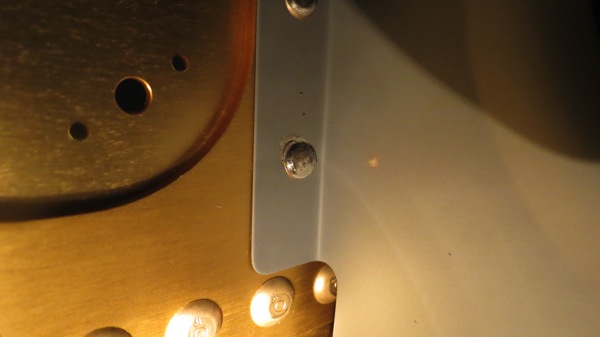I went out to the garage with pretty low expectations tonight. I figured I’d aim to shoot all the main wing rib rivets that I could manage by myself, and then just kind of wing it from there. Well, there were exactly three ribs I could do solo, so that took all of about…maybe 30 minutes. Josie is busy working overtime for a big work project, so I couldn’t recruit her to come out and help rivet.
One of my main short-term goals is to get this right wing skeleton finished so I can clear it off the workbench; right now workspace is hard to come by. Between Josie’s unavailability and needing to wait for that replacement rib (which should be here Monday), it seemed that being productive this weekend was going to be tough. So I decided to abandon riveting on the right wing skeleton for the time being, and we moved it over to the wing stand. That freed me up to do some more work on the left tank.
First order of business was to drill the attach screw holes on the outboard edge of the tank. These screws will go into nutplates that will be on the W-423 joint plate. This was pretty straightforward, but before drilling, I double-checked everything to ensure that the tank was in the proper place. It’s been a couple weeks since I last set it up there, and it’d be really annoying to misdrill holes because I didn’t verify alignment and such.
Here’s a picture of a #19 hole for one of the screws. Exciting, huh?

From here, I’d figured I’d pull the tank off and start looking at all the various internal parts. But then it occurred to me – I already had the thing clecoed together, and it was going to need to be match-drilled at some point…might as well take care of that now. First I pulled the tank off the spar, set it in the cradle, and match-drilled the baffle-to-rib holes. For the skin-to-rib holes, I put it back in place on the spar; the cradle limits access to some of those holes.
With that done, I marked the ribs and pulled the whole tank apart again:

I was on a roll, so I figured I’d go ahead and get all the match-drilling done. The only things left were the stiffeners for the bottom of the tank, which I cut and prepped a few days ago. So i got those out, clecoed them in place, and match-drilled them too.

The only prepunched holes that still need attention now are the attach screw holes along the aft edge of the skin. These just need to be drilled out to final size. However, I seem to recall reading something about problems with these holes cracking when dimpled. I think there was a specific approach to prevent those cracks, so I’m going to research that before I do anything.
I suppose tomorrow I’ll really get into the nuts and bolts of the tank’s innards.





























